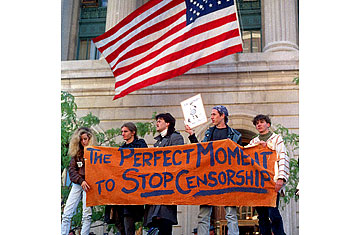
A Cincinnati protest, 1990
(2 of 2)
All this proved too much for the Corcoran's board of trustees. Though they had originally supported the cancellation, now they began backing away. Orr-Cahall, who had joined the Corcoran just a few months earlier, was left stranded. By December, having concluded that the cancellation was a mistake — "we should have damned the torpedoes," she said, "and gone full speed ahead" — she resigned.
A few months later, the Mapplethorpe bomb would go off again. The show traveled to the Contemporary Arts Center (CAC) in Cincinnati, Ohio. As soon as it arrived, police shut it down briefly so they could videotape the pictures. Those tapes would be used as evidence in the criminal trial of CAC director Dennis Barrie, who would find himself and his museum charged with obscenity in connection with seven Mapplethorpe photographs, five showing sadomasochistic sex and two portraits of naked children.
Taste Test
The cincinnatti exhibition quickly reopened and eventually played to 80,000 visitors, but by September 1990 Barrie was in court, facing up to a year in jail. The eight-member jury, four men and four women, were mostly blue-collar and suburban. Only three had ever been to a museum. Prosecutors were so confident that they would agree that Mapplethorpe's pictures were obscene that the only witnesses they called were police officers brought in to testify that the photographs had actually been in the show.
The strategy backfired. For five days the defense called a multitude of museum directors, critics and other experts to testify. (This led to some priceless moments, like when the Philadelphia curator who had organized the show explained how meticulously Mapplethorpe had positioned the wrist that was penetrating a man's anus.) But the larger argument — that however shocking some of them might be, the pictures could be considered as art — was sound and it worked. After just two hours of jury deliberation, Barrie and the museum were acquitted.
After that, "The Perfect Moment" was over, but the conservative war on the NEA was not. For years the NEA struggled to placate its critics. It established a review board to look into any complaints about work it funded. It required its beneficiaries to sign a pledge promising not to produce obscene art. But none of this appeased Republicans in Congress. After the GOP electoral sweep in 1994, they tried to abolish the agency altogether. When that failed, they cut its funding by more than a third. Artists angry about the NEA decency requirements took their grievances to federal courts, which more than once found the requirements unconstitutionally vague. In 1998 one of the cases reached the Supreme Court, only to result in a hair-splitting decision that satisfied no one.
Fights about government support for obscene art are rare these days and for an obvious reason: the government is a lot more careful about what it underwrites. After George W. Bush arrived at the White House, NEA funding started a slow climb back. President Barack Obama's first budget proposes to give the endowment $161.3 million. That figure, astonishingly, is still almost $8 million less than the agency got in 1989. Make no mistake, the battle over Mapplethorpe resulted in sustained harm to arts funding in the U.S. It was a perfect mess with a long, dismal aftermath.